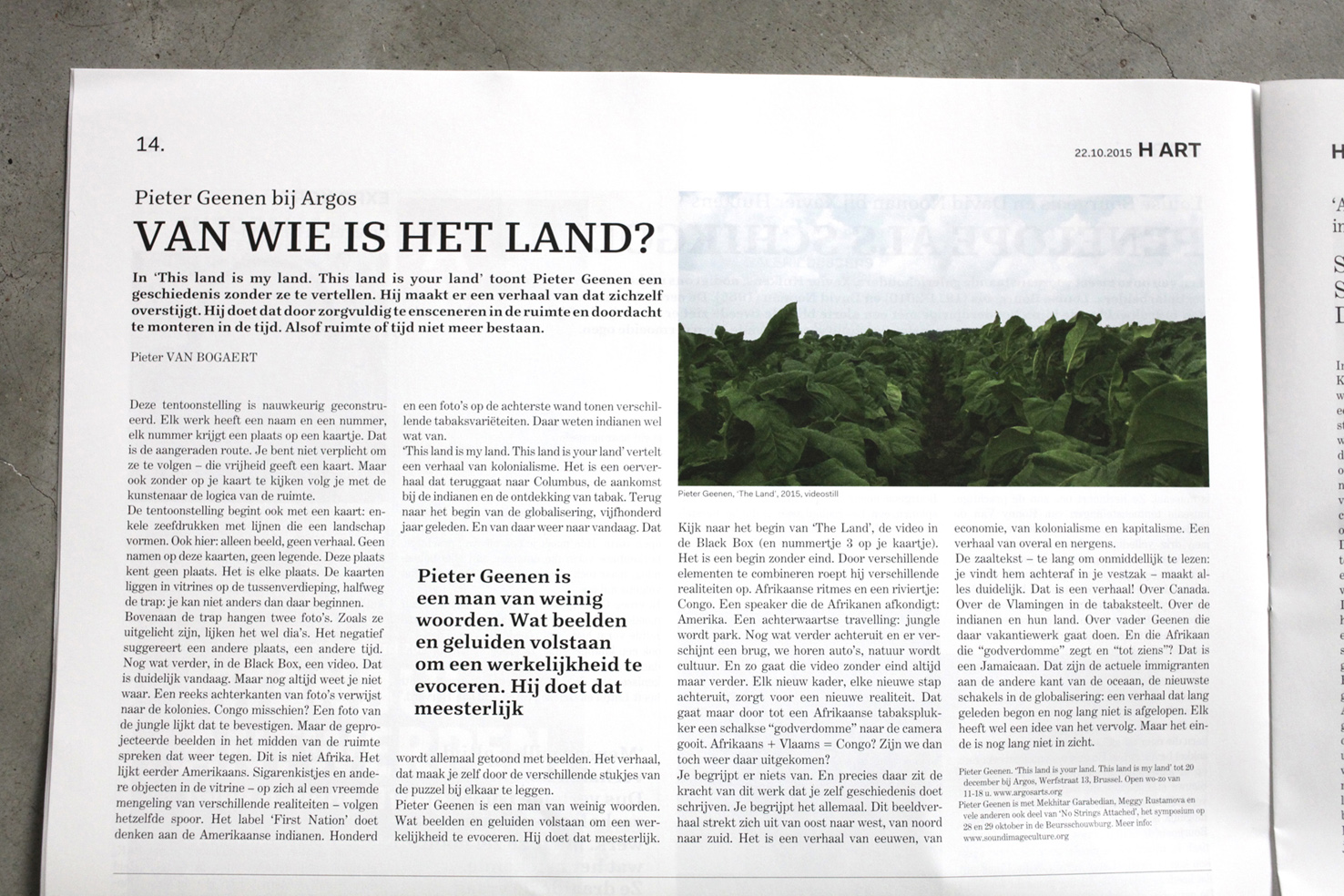
Pieter Geenen at Argos
WHO OWNS THE LAND?
In 'This land is my land. This land is your land' Pieter Geenen presents a history without telling it. He turns it into a story that transcends itself. Through accurate staging in space and considered editing in time. As if space and time cease to exist.
Pieter VAN BOGAERT
This exhibition is constructed with great care. Each work has a name and a number, each number corresponds to a location on a little map. This is the recommended route. Without any obligation – a freedom the map allows for. But even without looking at the map the artist takes you through the logic of the exhibition space.
The exhibition begins with a map as well: several screenprints with lines, tracing a landscape. Here too: image only, no story. No names on these maps, no key. This location is not located. It is every location. The maps are presented in displays on the mezzanine, halfway through the staircase: to start here is the only option.
At the top of the stairs two photos await. Because of the lighting they seem like slides. The negative suggests another place, another time. Beyond that, in the Black Box, a video. This is clearly the present. But where remains unclear. A series of backsides of photos refer to the colonies. The Congo, maybe? A photo of the jungle might confirm this. But the projected images in the middle of the space, on the other hand, are contradictory. This is not Africa. It is more American. Cigar-boxes and other objects on display – in itself a peculiar blending of various realities – follow the same trail. The label ‘First Nation’ is reminiscent of Native American Indians.
One hundred and one photos on the rear wall show various tobacco varieties. Indians are familiar with those, aren’t they?
'This land is my land. This land is your land' is a story about colonialism. It is a monomyth, which takes us back to Columbus, his arrival with the Indians and the discovery of tobacco. Back to the beginning of globalization, five hundred years ago. And from then back to the present. All shown with images. The story is your own creation, by assembling the various pieces of the puzzle.
Pieter Geenen is a man of few words. A couple of images and sounds suffice to evoke a reality. He does it masterfully.
Take the beginning of ‘The Land’, the video in the Black Box (and number 3 on your map). It is a beginning without end. By combining several elements he evokes different realities. African rhythms and a tiny river: the Congo. A speaker announces the Africans: America. A backward travelling: jungle turns into park. Further back still a bridge appears, we can hear cars, nature turns into culture. And the endless video keeps going. Each new frame, each new step back, reveals a new reality. This goes on and on, until an African tobacco picker throws a playful “godverdomme” at the camera. African + Flemish = the Congo? Is that where we ended up again?
You are at a loss. And that is precisely the force behind this work that forces you to write a history of your own. You understand all of it. This visual narrative spreads out from east to west, from north to south. It is a story about centuries, about economy, about colonialism and capitalism. A story about everywhere and nowhere.
The exhibition text – too long to read at once: afterwards you find it sitting in your pocket – makes things clear. That is a story! About Canada. About the Flemish and tobacco-growing. About the Indians and their country. About father Geenen, who took a summer job there. And the African who says “godverdomme” and “tot ziens”? He’s Jamaican. Those are the current immigrants on the other side of the ocean, the newest link in globalization: a story that started a long time ago and that is by no means over.
|
|
|